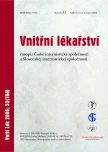-
Medical journals
- Career
How can the autoantibody detection help in the diagnostics and evaluation of connective tissue diseases?
Authors: J. Vencovský
Authors‘ workplace: Revmatologický ústav, Praha, ředitel prof. MUDr. Karel Pavelka, DrSc.
Published in: Vnitř Lék 2006; 52(7-8): 697-701
Category: 130th Internal Medicine Day - Rheumatology in clinical practice
Overview
Autoantibodies are immunoglobulins that are directed against self tissues. Variable structural components of the cells or their products may be the targets. Production of a majority of autoantibodies is a physiological phenomenon, which does not have to lead to the disease. Autoantibodies that are associated with connective tissue diseases are produced in high levels, they are usually of high affinity and IgG isotype. Connective tissue diseases are characterized by a frequent presence of organ non-specific autoantibodies. Some of their properties can be used for clinical evaluation. The presence of the autoantibody may directly diagnose a specific connective tissue disease or support such a diagnosis. Some autoantibodies associate with typical clinical signs and symptoms, which sometimes form a specific subgroup with a different prognosis. Follow-up of the levels of autoantibodies is less significant, although they may occasionally help to assess the activity and contribute to a therapeutic decision. It is important to be aware of some technical limits that may affect the detection and interpretation of autoantibodies in the laboratory.
Key words:
autoantibodies - connective tissue diseases - antinuclear antibodies
Sources
1. Vencovský J. Autoprotilátky. In: Tlaskalová-Hogenová H, Holáň V, Bilej M (eds). Buněčné a molekulární základy imunologie 2003. Praha: Česká imunologická společnost 2003 : 141-149.
2. Vencovský J. Autoimunitní systémová onemocnění - minimum pro praxi. Praha: Triton 1998.
3. Vencovský J. Laboratorní diagnostika u systémových revmatických onemocnění. In: Zima T (ed). Laboratorní diagnostika. Praha: Galén 2002 : 248-258.
4. Dostál C, Vencovský J et al. Systémový lupus erytematodes. Praha: Medprint 1997.
5. Vencovský J, Kafková J, Štork J et al. Antinukleární a anticytoplasmatické autoprotilátky u systémových revmatických onemocnění - vyšetření imunoblotingem. Čes Revmatol 1997; 5 : 71-81.
6. Tan EM, Cohen AS, Fries JS et al. The 1982 revised criteria for the classification of systemic lupus erythematosus. Arthritis Rheum 1982; 25 : 1271-1277.
7. Hochberg MC. Updating the American College of Rheumatology revised criteria for the classification of systemic lupus erythematosus. Arthritis Rheum 1997; 40 : 1725.
8. Sharp GC, Irvin WS, Tan EM et al. Mixed connective tissue disease - an apparently distinct rheumatic disease syndrome associated with a specific antibody to an extractable nuclear antigen (ENA). Am J Med 1972; 52 : 148-159.
9. Isshi K, Hirohata S. Differential roles of the anti-ribosomal P antibody and antineuronal antibody in the pathogenesis of central nervous system involvement in systemic lupus erythematosus. Arthritis Rheum 1998; 41 : 1819-1827.
10. Cortes-Hernandez J, Ordi-Ros J, Labrador M et al. Antihistone and anti-double-stranded deoxyribonucleic acid antibodies are associated with renal disease in systemic lupus erythematosus. Am J Med 2004; 116 : 165-173.
11. Salomonsson S, Sonesson SE, Ottosson L et al. Ro/SSA autoantibodies directly bind cardiomyocytes, disturb calcium homeostasis, and mediate congenital heart block. J Exp Med 2005; 201 : 11-17.
12. Vencovský J, Williams DG, Field M et al. Clinical associations of IgG antibodies to the RNP p-67 polypeptide in patients with systemic lupus erythematosus. Ann Rheum Dis 1992; 51 : 1313-1317.
13. Love LA, Leff RL, Fraser DD et al. A new approach to the classification of idiopathic inflammatory myopathy: Myositis-specific autoantibodies define useful homogeneous patients groups. Medicine 1991; 70 : 360-373.
14. Miyakis S, Lockshin MD, Atsumi T et al. International consensus statement on an update of the classification criteria for definite antiphospholipid syndrome (APS). J Thromb Haemost 2006; 4 : 295-306.
15. Moroi Y, Peebles C, Fritzler MJ et al. Autoantibody to centromere (kinetochore) in scleroderma sera. Proc Natl Acad Sci USA 1980; 77 : 1627-1631.
16. Vencovský J, Šedová L, Růžičková Š. Protilátky proti citrulinovaným proteinům u revmatoidní artritidy. Čes Revmatol 2005; 13 : 164-175.
17. Vencovský J, Šedová L, Macháček S et al. Autoantibodies can be prognostic markers of an erosive disease in early rheumatoid arthritis. Ann Rheum Dis 2003; 62 : 427-430.
18. Smeenk R, Brinkman K, Van den Brink H et al. Antibodies to DNA in patients with systemic lupus erythematosus. Their role in the diagnosis, the follow-up and the pathogenesis of the disease. Clin Rheumatol 1990 (Suppl 1); 9 : 100-110.
19. van Gaalen FA, Linn-Rasker SP, van Venrooij WJ et al. Autoantibodies to cyclic citrullinated peptides predict progression to rheumatoid arthritis in patients with undifferentiated arthritis: a prospective cohort study. Arthritis Rheum 2004; 50 : 709-715.
Labels
Diabetology Endocrinology Internal medicine
Article was published inInternal Medicine

2006 Issue 7-8-
All articles in this issue
- Problems of cardiovascular toxicity of coxibs and non-selective NSA
- Nonsteroidal antiinflammatory drugs and the kidney
- Polymyalgia rheumatica and giant cell arteritis – first results of a year-long study
- How can the autoantibody detection help in the diagnostics and evaluation of connective tissue diseases?
- Treatment of early arthritis – recommendations of EULAR
- Gastroduodenal complications associated with non-steroidal anti-inflammatory drugs in Slovak Republic: results of one-year prospective study
- Systemic lupus erythematodes
- New Trends in Diagnosis and Treatment of Systemic Sclerosis
- Antiphospholipid syndrome
- Early diagnostics of ankylosing spondylitis
- Ankylosing spondylitis – the current situation and new therapeutic options
- Pathogenesis, diagnostics and therapy of gout
- Musculoskeletal manifestations of diabetes mellitus
- Present possibilities of diagnostics and therapy of osteoporosis
- Internal Medicine
- Journal archive
- Current issue
- Online only
- About the journal
Most read in this issue- Nonsteroidal antiinflammatory drugs and the kidney
- Systemic lupus erythematodes
- Ankylosing spondylitis – the current situation and new therapeutic options
- Antiphospholipid syndrome
Login#ADS_BOTTOM_SCRIPTS#Forgotten passwordEnter the email address that you registered with. We will send you instructions on how to set a new password.
- Career

